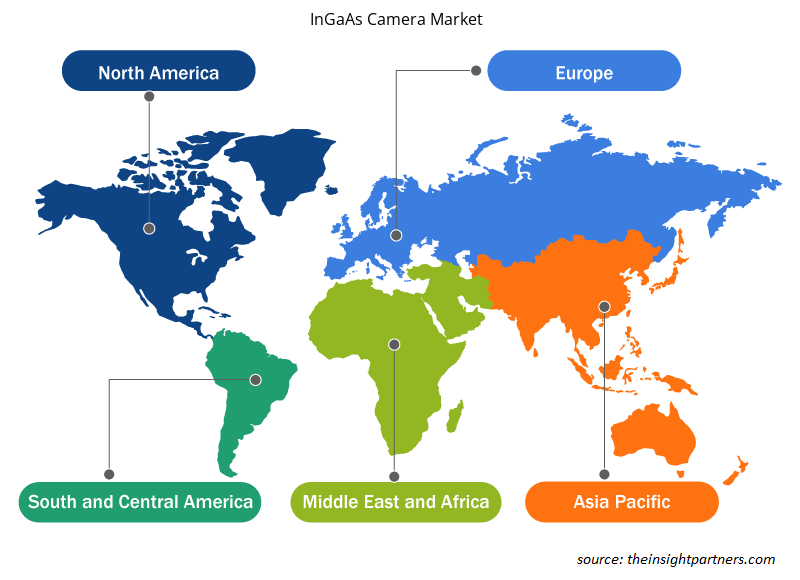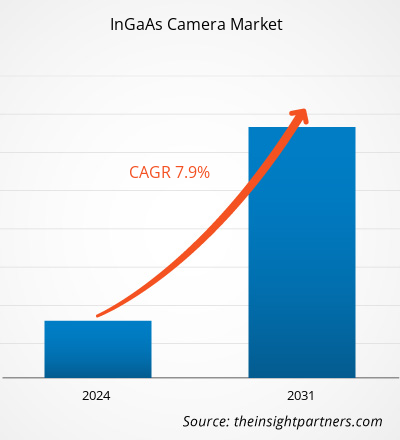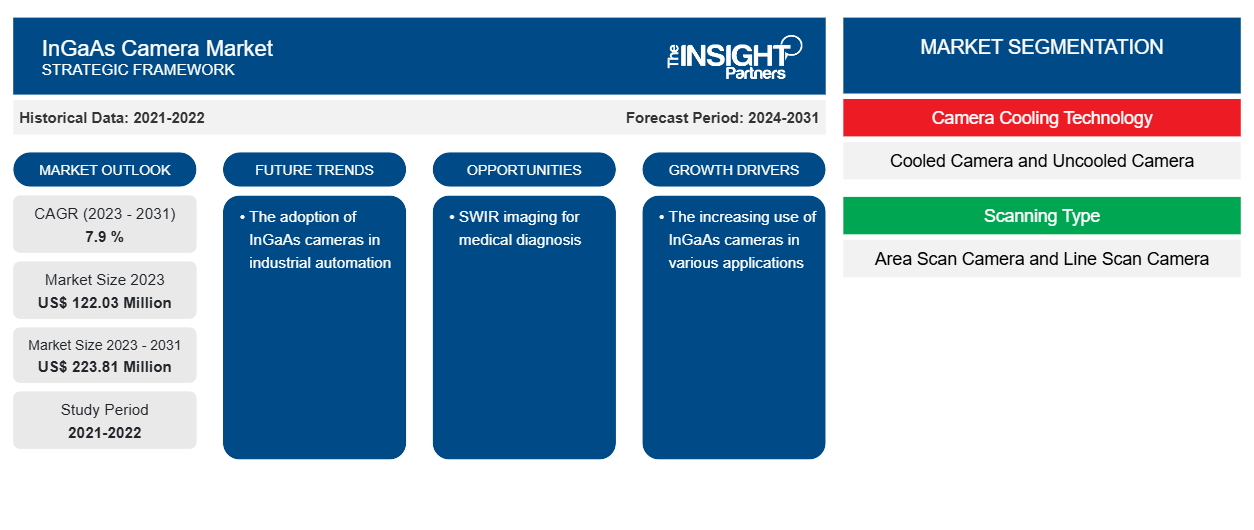La taille du marché des caméras InGaAs devrait atteindre 223,81 millions USD d'ici 2031, contre 122,03 millions USD en 2023. Le marché devrait enregistrer un TCAC de 7,9 % au cours de la période 2023-2031. L'adoption des caméras InGaAs dans l'automatisation industrielle devrait rester une tendance clé du marché.
Analyse du marché des caméras InGaAs
La croissance du marché des caméras InGaAs est attribuée à l'utilisation accrue de ces caméras dans diverses applications, telles que l'automatisation industrielle et le diagnostic médical . Une caméra SWIR peut empêcher cela et ainsi assurer un processus de production fluide. Par conséquent, l'augmentation de l'utilisation des caméras InGaAs dans diverses applications stimule le marché des caméras InGaAs. Les techniques d'imagerie SWIR, telles que l'imagerie hyperspectrale SWIR pour les applications biomédicales et un système microscopique holographique numérique à large bande (VIS+SWIR) basé sur un nouveau capteur d'image à points quantiques (QD), sont également abordées. Ainsi, l'augmentation de l'utilisation des caméras InGaAs dans diverses applications stimule le marché.
Aperçu du marché des caméras InGaAs
Les capteurs InGaAs sont utilisés en sciences physiques et biologiques et nécessitent une sensibilité élevée sur la plage de longueurs d'onde de 900 à 1700 nm, appelée infrarouge à ondes courtes (SWIR). Certains capteurs InGaAs peuvent mesurer jusqu'à 2500 nm en raison des changements de composition du matériau. Bien que les caméras CCD à base de silicium possèdent une sensibilité sur la plage UV-NIR, les propriétés de bande interdite du silicium empêchent ces CCD d'avoir une sensibilité suffisante au-delà de 1100 nm. Les caméras InGaAs ont une bande interdite plus faible, ce qui fait de ce matériau le matériau privilégié pour les applications dans la région de l'infrarouge à ondes courtes (SWIR).
Personnalisez ce rapport en fonction de vos besoins
Vous bénéficierez d'une personnalisation gratuite de n'importe quel rapport, y compris de certaines parties de ce rapport, d'une analyse au niveau des pays, d'un pack de données Excel, ainsi que d'offres et de remises exceptionnelles pour les start-ups et les universités.
-
Obtenez les principales tendances clés du marché de ce rapport.Cet échantillon GRATUIT comprendra une analyse de données, allant des tendances du marché aux estimations et prévisions.
Facteurs moteurs et opportunités du marché des caméras InGaAs
L'utilisation croissante des caméras InGaAs dans diverses applications
L'inspection des cristaux et des lingots de silicium (également appelés briques) est l'une des applications les plus populaires des caméras InGaAs dans le secteur des semi-conducteurs. La capacité de voir dans le silicium à une longueur d'onde supérieure à 1 150 nm offre aux caméras InGaAs une solution adaptée pour détecter les inclusions, telles que les impuretés dans un cristal ou un lingot, qui peuvent s'accumuler au cours du processus de production. Les impuretés sont critiques lors de l'observation des lingots dans des plaquettes minces avec une chaîne en diamant. Si la chaîne heurte un élément, comme un petit morceau de métal, la chaîne, extrêmement coûteuse, peut se briser. Le remplacement d'une chaîne génère non seulement des coûts, mais entraîne également une baisse de la productivité et des bénéfices. Une caméra SWIR peut éviter cela et ainsi garantir un processus de production fluide. Par conséquent, l'utilisation croissante des caméras InGaAs dans diverses applications stimule le marché des caméras InGaAs.
Imagerie SWIR pour le diagnostic médical
L'imagerie SWIR est utilisée dans le diagnostic médical. Les techniques en développement basées sur la lumière SWIR, notamment la fabrication et l'utilisation de nanoparticules SWIR comme agents photothermiques et nanothermomètres luminescents, ainsi que les avancées récentes dans la structure, la conception et les applications biomédicales liées au SWIR des nanoparticules dopées aux terres rares (REDN). Les REDN font partie des émetteurs SWIR les plus lumineux et les plus biocompatibles. Les techniques d'imagerie SWIR, telles que l'imagerie hyperspectrale SWIR pour les applications biomédicales et un système microscopique holographique numérique à large bande (VIS+SWIR) basé sur un nouveau capteur d'image à points quantiques (QD), sont également abordées. Ainsi, l'utilisation croissante des caméras InGaAs dans diverses applications stimule le marché.
Analyse de segmentation du rapport sur le marché des caméras InGaAs
Les segments clés qui ont contribué à la dérivation de l’analyse du marché des caméras InGaAs sont la technologie de refroidissement des caméras, le type de numérisation et l’application.
- En fonction de la technologie de refroidissement des caméras, le marché des caméras InGaAs est divisé en caméras refroidies et caméras non refroidies. Le segment des logiciels détenait une part de marché plus importante en 2023.
- En fonction du type de numérisation, le marché est segmenté en caméras à balayage de zone et caméras à balayage de ligne.
- En termes d'application, le marché est segmenté en militaire et défense, automatisation industrielle et recherche scientifique.
Analyse des parts de marché des caméras InGaAs par zone géographique
La portée géographique du rapport sur le marché des caméras InGaAs est principalement divisée en cinq régions : Amérique du Nord, Asie-Pacifique, Europe, Moyen-Orient et Afrique, et Amérique du Sud et centrale.
L'APAC domine le marché des caméras InGaAs. La demande croissante d'adoption de l'automatisation dans les industries, les tests non destructifs et l'adoption croissante des applications de vision artificielle devraient stimuler la croissance du marché des caméras InGaAs au cours de la période de prévision.
Aperçu régional du marché des caméras InGaAs
Les tendances et facteurs régionaux influençant le marché des caméras InGaAs tout au long de la période de prévision ont été expliqués en détail par les analystes d’Insight Partners. Cette section traite également des segments et de la géographie du marché des caméras InGaAs en Amérique du Nord, en Europe, en Asie-Pacifique, au Moyen-Orient et en Afrique, ainsi qu’en Amérique du Sud et en Amérique centrale.

- Obtenez les données régionales spécifiques au marché des caméras InGaAs
Portée du rapport sur le marché des caméras InGaAs
| Attribut de rapport | Détails |
|---|---|
| Taille du marché en 2023 | 122,03 millions de dollars américains |
| Taille du marché d'ici 2031 | 223,81 millions de dollars américains |
| Taux de croissance annuel composé mondial (2023-2031) | 7,9 % |
| Données historiques | 2021-2022 |
| Période de prévision | 2024-2031 |
| Segments couverts |
Par la technologie de refroidissement de la caméra
|
| Régions et pays couverts |
Amérique du Nord
|
| Leaders du marché et profils d'entreprises clés |
|
Densité des acteurs du marché : comprendre son impact sur la dynamique des entreprises
Le marché des caméras InGaAs connaît une croissance rapide, tirée par la demande croissante des utilisateurs finaux en raison de facteurs tels que l'évolution des préférences des consommateurs, les avancées technologiques et une plus grande sensibilisation aux avantages du produit. À mesure que la demande augmente, les entreprises élargissent leurs offres, innovent pour répondre aux besoins des consommateurs et capitalisent sur les tendances émergentes, ce qui alimente davantage la croissance du marché.
La densité des acteurs du marché fait référence à la répartition des entreprises ou des sociétés opérant sur un marché ou un secteur particulier. Elle indique le nombre de concurrents (acteurs du marché) présents sur un marché donné par rapport à sa taille ou à sa valeur marchande totale.
Les principales entreprises opérant sur le marché des caméras InGaAs sont :
- Hamamatsu Photonics KK
- Allied Vision Technologies GmbH
- Nouvelles technologies d'imagerie
- Pembroke Instruments SARL
- Polytec GmbH
- Raptor Photonics Limitée
Avis de non-responsabilité : les sociétés répertoriées ci-dessus ne sont pas classées dans un ordre particulier.

- Obtenez un aperçu des principaux acteurs du marché des caméras InGaAs
Actualités et développements récents du marché des caméras InGaAs
Le marché des caméras InGaAs est évalué en collectant des données qualitatives et quantitatives après des recherches primaires et secondaires, qui comprennent d'importantes publications d'entreprise, des données d'association et des bases de données. Quelques-uns des développements du marché des caméras InGaAs sont répertoriés ci-dessous :
- Hamamatsu Photonics, l'un des principaux fournisseurs de technologies et de produits photoniques de pointe, a présenté une nouvelle caméra InGaAs avec une sensibilité dans la région visible à proche infrarouge de 400 nm à 1700 nm. (Source : Hamamatsu Photonics, communiqué de presse, février 2024.)
- BlueVision Ltd., Japon a lancé une nouvelle caméra à balayage linéaire SWIR 1K nommée BV-C3110, qui est un tout nouveau capteur InGaAs 1K en avril 2021 (Source : BlueVision Ltd, communiqué de presse, avril 2021)
Rapport sur le marché des caméras InGaAs et livrables
Le rapport « Taille et prévisions du marché des caméras InGaAs (2021-2031) » fournit une analyse détaillée du marché couvrant les domaines ci-dessous :
- Taille et prévisions du marché des caméras InGaAs aux niveaux mondial, régional et national pour tous les segments de marché clés couverts par le périmètre
- Tendances du marché des caméras InGaAs, ainsi que la dynamique du marché telle que les moteurs, les contraintes et les opportunités clés
- Analyse détaillée des cinq forces de PEST/Porter et SWOT
- Analyse du marché des caméras InGaAs couvrant les principales tendances du marché, le cadre mondial et régional, les principaux acteurs, les réglementations et les développements récents du marché
- Analyse du paysage industriel et de la concurrence couvrant la concentration du marché, l'analyse de la carte thermique, les principaux acteurs et les développements récents pour le marché des caméras InGaAs
- Profils d'entreprise détaillés
- Analyse historique (2 ans), année de base, prévision (7 ans) avec TCAC
- Analyse PEST et SWOT
- Taille du marché Valeur / Volume - Mondial, Régional, Pays
- Industrie et paysage concurrentiel
- Ensemble de données Excel
Rapports récents
Rapports connexes
Témoignages
Raison d'acheter
- Prise de décision éclairée
- Compréhension de la dynamique du marché
- Analyse concurrentielle
- Connaissances clients
- Prévisions de marché
- Atténuation des risques
- Planification stratégique
- Justification des investissements
- Identification des marchés émergents
- Amélioration des stratégies marketing
- Amélioration de l'efficacité opérationnelle
- Alignement sur les tendances réglementaires























 Obtenez un échantillon gratuit pour - Marché des caméras InGaAs
Obtenez un échantillon gratuit pour - Marché des caméras InGaAs